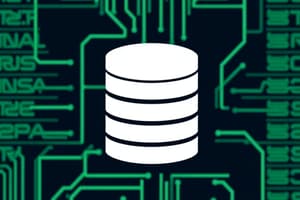Podcast
Questions and Answers
Which of the following best describes the primary function of a Database Management System (DBMS)?
Which of the following best describes the primary function of a Database Management System (DBMS)?
- Developing programming languages for database interaction.
- Designing user interfaces for database applications.
- Creating and managing large amounts of data efficiently. (correct)
- Providing hardware solutions for data storage.
In the context of database systems, what does 'defining' a database primarily involve?
In the context of database systems, what does 'defining' a database primarily involve?
- Allowing multiple users to access data.
- Specifying data types, structure, and constraints. (correct)
- Storing data into a storage media.
- Retrieving and updating data.
Which database generation introduced relational database technology to address the lack of data independence?
Which database generation introduced relational database technology to address the lack of data independence?
- First generation
- Second generation
- Fourth generation (correct)
- Third generation
Which of the following is NOT a typical requirement of a database system?
Which of the following is NOT a typical requirement of a database system?
What is the primary difference between a file system and a database system regarding data management?
What is the primary difference between a file system and a database system regarding data management?
In the context of database systems, atomicity is most closely related to:
In the context of database systems, atomicity is most closely related to:
Which architecture is characterized by having the user interface and business logic running on the client side, with the data tier on the server side?
Which architecture is characterized by having the user interface and business logic running on the client side, with the data tier on the server side?
In a three-tier client/server architecture, what is the primary function of the business tier?
In a three-tier client/server architecture, what is the primary function of the business tier?
Which component of a database system is responsible for checking user credentials and testing for integrity constraints?
Which component of a database system is responsible for checking user credentials and testing for integrity constraints?
Which module handles queries as well as requests for modification of the data and metadata?
Which module handles queries as well as requests for modification of the data and metadata?
What is the main characteristic of the hierarchical data model?
What is the main characteristic of the hierarchical data model?
What key concept was introduced by the network model that was not available in the hierarchical model?
What key concept was introduced by the network model that was not available in the hierarchical model?
Which of the following is a property unique to relational tables?
Which of the following is a property unique to relational tables?
What does an 'attribute' represent in the Entity-Relationship (E/R) model?
What does an 'attribute' represent in the Entity-Relationship (E/R) model?
Which model is considered a high-level implementation data model that is closer to the conceptual model?
Which model is considered a high-level implementation data model that is closer to the conceptual model?
During which step of database design are the data, information, and system components required by the system determined?
During which step of database design are the data, information, and system components required by the system determined?
Which aspect is addressed when identifying 'user views' during the requirements analysis for database design?
Which aspect is addressed when identifying 'user views' during the requirements analysis for database design?
What is the outcome of the 'conceptual design' phase in database design?
What is the outcome of the 'conceptual design' phase in database design?
What is the focus of the 'physical design' phase in database design?
What is the focus of the 'physical design' phase in database design?
What action best describes database 'implementation'?
What action best describes database 'implementation'?
Flashcards
Database Management System (DBMS)
Database Management System (DBMS)
A tool for creating and managing large amounts of data efficiently and allowing it to persist over time.
Defining (Database)
Defining (Database)
Specifying data types, structure, and constraints in a database.
Constructing (Database)
Constructing (Database)
The process of storing data into a storage medium within a database.
Manipulating (Database)
Manipulating (Database)
Signup and view all the flashcards
Sharing (Database)
Sharing (Database)
Signup and view all the flashcards
Consistency (Database)
Consistency (Database)
Signup and view all the flashcards
Concurrency (Database)
Concurrency (Database)
Signup and view all the flashcards
Data Definition Language (DDL)
Data Definition Language (DDL)
Signup and view all the flashcards
Data Manipulation Language (DML)
Data Manipulation Language (DML)
Signup and view all the flashcards
Centralized Database System Architecture
Centralized Database System Architecture
Signup and view all the flashcards
Client/Server Architecture (Database)
Client/Server Architecture (Database)
Signup and view all the flashcards
Two-Tier Client/Server Architecture
Two-Tier Client/Server Architecture
Signup and view all the flashcards
Three-Tier Client/Server Architecture
Three-Tier Client/Server Architecture
Signup and view all the flashcards
Storage Manager
Storage Manager
Signup and view all the flashcards
Authorization and Integrity Manager
Authorization and Integrity Manager
Signup and view all the flashcards
Hierarchical Model
Hierarchical Model
Signup and view all the flashcards
Entity-Relationship (E/R) Model
Entity-Relationship (E/R) Model
Signup and view all the flashcards
Requirements Analysis
Requirements Analysis
Signup and view all the flashcards
Implementation (Database)
Implementation (Database)
Signup and view all the flashcards
Study Notes
Introduction to Database Systems
- A database can be thought of as a repository or collection of data
- It stores, maintains, and presents data efficiently to applications and users
- Databases represent real-world aspects, contain related data, and are built for specific situations
Database Management System (DBMS)
- A DBMS is a tool for creating and managing large amounts of data efficiently over time
- It defines data types, structure, and constraints
- The process of constructing involves storing data into a storage medium
- Manipulation involves retrieving and updating data in storage
- Sharing allows multiple users to access data
Evolution of Database Systems
- Database technology has evolved through four generations
- Currently on the cusp of the fifth generation
- The first generation used file systems like ISAM and VSAM
- Second-generation systems were hierarchical, such as IMS and System 2000
- Third-generation systems used the network model (CODASYL), like IDS, TOTAL, ADABAS, IDMS
- The second and third generations enabled integrated database sharing among users
- The fourth generation introduced relational database technology to solve data independence issues using a declarative query approach
- The fifth generation aims for richer data models and facilities for broader applications beyond business data processing
History Landmarks
- 1950s-1960s: Magnetic disks are introduced for data storage, data reading from tapes and cards was sequential
- Late 1960s-1970s: Hard disks enabled direct data access, Codd's relational model paper emerged
- 1980s: Relational database technology was realized, Oracle, SQL/DB, DB2, and INGRES were introduced
- Late 1990s: The WWW and multimedia advancements push database systems further, object-oriented programming strained unified language
Database System Requirements
- Key factors include data sharing
- Consistency ensures data is stored, retrieved, and shared efficiently
- Concurrency allows multiple users to retrieve data simultaneously
- Performance requires reasonable response times
- Standard Adherence: Supports standard languages like SQL:
- Data Definition Language (DDL) enables users to create and define database schemas
- Data Manipulation Language (DML) enables users to query and manipulate data
- Security sets access permissions
- Reliability keeps stored data intact and ensures recovery from failures
Database System vs. File System
- File systems lack features of database systems
- Data redundancy and Inconsistency: Files and applications vary in format, leading to duplication
- Data Isolation: Related data is scattered across files
- Difficulty in Accessing Data: File systems lack responsive data-retrieval
- Integrity Issues: Maintaining constraints across files is difficult
- Atomicity Issues: Restoring consistent state after failures is crucial
- Concurrent Access Anomalies: Supervision of application is difficult
- Security Problems: Systems are vulnerable to security threats
Database System Architecture
- Centralized systems run on a single computer without interacting with others except for display purposes
- Client/Server architecture separates client and server processes
- Two-Tier Client/Server Architecture:
- Client processes provide the user interface
- Server processes interface with data storage
- The logic is divided between the client and server
- Fat clients handle user and business tiers, while thin clients handle only the user tier
Three-Tier Client/Server Architecture
- It consists of modularly separated tiers on three machines
- User Tier (GUI or Web Interface): presents the user interface
- Business Tier (Application Server or Web Server): incorporates business rules
- Data Tier (Data Server): comprises data storage
- Components and Functionalities of a Database System
Storage Manager
- An interface between low-level data and application programs
- Main components:
- Authorization and Integrity Manager: checks user credentials and integrity constraints
- Transaction Manager: preserves consistency and avoids conflicts
- File Manager: manages disk storage allocation and data structure
- Buffer Manager: fetches data from disk storage to main memory
Query Processor
- Handles queries and data modification requests
- Components:
- DDL Interpreter (Compiler): processes DDL statements and records definitions in the data dictionary
- DML Compiler: analyzes, translates, and optimizes DML statements
- Query Evaluation Engine: executes low-level instructions generated by the DML compiler
Types of Data Models
- A data model is a conceptual tool for describing the database schema
- It includes data, relationships, semantics, and consistency constraints
Hierarchical Model
- Data is organized in a tree structure with parent-child relationships
- Record types are equivalent to tables, with records as rows
- It was popularized by IBM's Information Management System (IMS) DBMS
Network Model
- Network model is a many-to-many relationships data model
- The basic construct is the set construct, consisting of an owner record type, a set name, and a member record type.
Relational Model
- Based on E.F. Codd's relational algebra principles
- Data and relations are organized in tables with records and columns
- Properties of Relational Tables:
- Values are atomic
- Rows are unique
- Column values are of the same kind
- Sequence of Columns is insignificant
- Sequence of Rows is insignificant
- Each Column has a unique name
Implementation and Conceptual Data Models
- Network, hierarchical, and relational models are implementation data models
- High-level (conceptual) data models focus on user perception of data
- Entity-Relationship (E/R) Model:
- Based on entities, attributes, and relationships
- Entity: represents a real world object
- Attribute: describes an entity
- Relationship: is an association among entities
- The E/R model is diagrammatical using rectangles, ellipses, diamonds, and lines
Object-Oriented Model
- Object-Oriented Programming (OOP) evolves into Object DBMS (ODBMS)
- High-level implementation data model
- Combination with the relational model leads to object-relational data model
Steps of Database Design
- Steps:
- Requirements analysis specifies system requirements based on user input
- Design specifies how the system addresses requirements
- Implementation translates design specifications into a working system
Requirement Analysis
- Determines data, information, system components, and analysis functions
- Involves user interviews and formal specifications
- Considers:
- User views
- Data elements
- Primary keys
- Relationships
- Operational requirements
Steps in Requirement Analysis
- Scope identification
- Metadata collection standards
- User view identification
- Data dictionary creation
- Volume and usage pattern identification
- Operational requirement identification
- Outputs include data and functional requirements
Design
- Conceptual Design: Synthesizes information from requirements analysis
- Implementation (Logical) Design: Transforms the conceptual data model into an internal schema for a DBMS
- Physical Design: Involves design of internal storage structures, record formats, access methods, and record blocking
Implementation
- Translates the implementation design into a database management system
- Involves entities, objects, relationships, and constraints
Studying That Suits You
Use AI to generate personalized quizzes and flashcards to suit your learning preferences.




